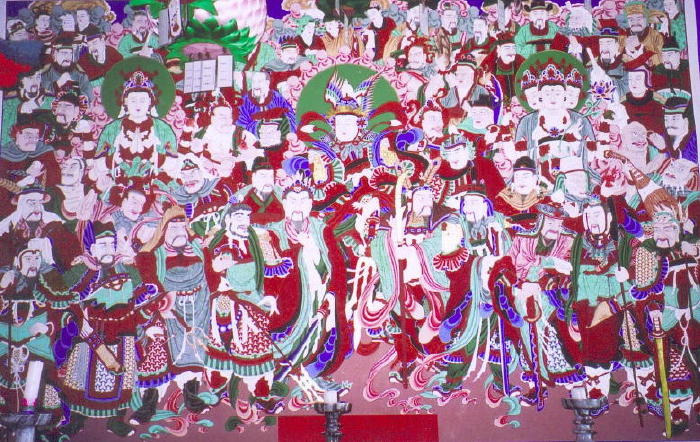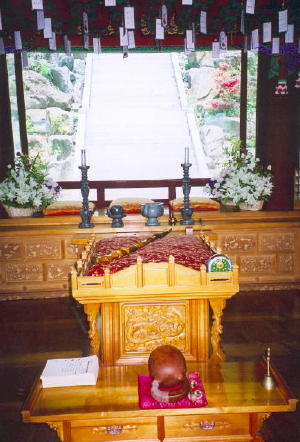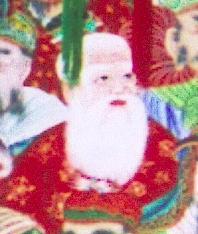| Beobhwa-san 법화산 the Dharma-Blossom Mountain in the Inner-Northeast / Hamyang County Sector of Jiri-san page one |
symbol of Buddhist enlightenment, which is considered to be the fruit or flower (best & final result) of
the Buddha-teachings; Jiri-san itself is considered enlightening or at least wisdom-granting (see
opening page), and so this name for one of its primary foothills follows-on nicely. It's a 1000-meter
mountain, the highest of Jiri's surrounding peaks, located in Hyucheon-myeon District of Hamyang
County on Jiri's northeast. The Eomcheon-gang River flows NE past its southern borders.
the Buddha-teachings; Jiri-san itself is considered enlightening or at least wisdom-granting (see
opening page), and so this name for one of its primary foothills follows-on nicely. It's a 1000-meter
mountain, the highest of Jiri's surrounding peaks, located in Hyucheon-myeon District of Hamyang
County on Jiri's northeast. The Eomcheon-gang River flows NE past its southern borders.
Above is the Main Hall of Southern Beobhwa-sa [Dharma-Blossom Temple], about 700 meters high, on
a steep east-facing slope but just south of the 1000-m summit -- an auspicious hyeol location -- and
there's another, ancient, one on the north slopes with the same name (see next page). This one claims
to also be an ancient traditional temple of Jiri-san, but physical or recorded evidence for that is lacking.
a steep east-facing slope but just south of the 1000-m summit -- an auspicious hyeol location -- and
there's another, ancient, one on the north slopes with the same name (see next page). This one claims
to also be an ancient traditional temple of Jiri-san, but physical or recorded evidence for that is lacking.


San-shin is well-done but
a bit hard to pick out in
the Shinjung-taenghwa
in that Main Hall.
a bit hard to pick out in
the Shinjung-taenghwa
in that Main Hall.


| The new Samseong-gak [Three Sages Shrine] of Southern Beobhwa-sa, and the excellent modern Dokseong painting found inside of it (with San-shin below; the Chilseong is not here, but in the Upper Main Hall, seen below on this page). In an extremely rare motif, the "Lonely Saint" is flanked by two beautiful young women instead of the usual children -- looking not so lonely at all! He looks surprised by his good fortune... |




The very modern San-shin painting enshrined in that
Samseong-gak features three finely-drawn dongja,
one boy curiously standing separately in the top-right.
There are great waterfalls and a very twisted pine-tree
in the background.
Samseong-gak features three finely-drawn dongja,
one boy curiously standing separately in the top-right.
There are great waterfalls and a very twisted pine-tree
in the background.

| Excellent lotus-flower-and-other-motif dancheong and a very modern-style tiger with three cubs are painted on the outside wall of that shrine -- note how the tiger's nose is exaggeratedly big, like one on the famous Yangban and Seonbi masks of Andong's Hahoe Village Talchum [Mask-Dance]!!! |




Details: a spring of drinkable water at the foot of the pagoda's stairway, and the Shipi-ji [12 Auspicious
Animals of the Oriental Zodiac] around its base. Shipi-ji stone-carvings are becoming more popular in the
Neo-Traditionalist wave, as an imitation of the very rare ancient motif on Shilla stoneworks, now seen as
uniquely characteristic of Korea's arts -- they are found only on a few tombs and pagodas in the Shilla capital
Gyeongju -- and in two treasures here at Jiri-san -- compare with those cases, at Hwaeom-sa & Yeongok-sa.
Animals of the Oriental Zodiac] around its base. Shipi-ji stone-carvings are becoming more popular in the
Neo-Traditionalist wave, as an imitation of the very rare ancient motif on Shilla stoneworks, now seen as
uniquely characteristic of Korea's arts -- they are found only on a few tombs and pagodas in the Shilla capital
Gyeongju -- and in two treasures here at Jiri-san -- compare with those cases, at Hwaeom-sa & Yeongok-sa.


| The excellent modern Chil-seong painting in that Hall, with unusual curly-bearded Bukseong-shin. |


| The excellent modern Shin-jung painting in that Hall, in which San-shin (detail above) is plain & hard-to-find. |

A very unusual but magnificent feature in this Upper Hall is this altar-display of ritual-portraits of the
21 greatest Masters of Korean Buddhism from Won-gwang, Jajang, Wonhyo & Uisang through
Chingpyo, Uicheon, Jineul Bojo and Seosan right up to Gyeongheo, Gusan and Seongcheol (etc)!
21 greatest Masters of Korean Buddhism from Won-gwang, Jajang, Wonhyo & Uisang through
Chingpyo, Uicheon, Jineul Bojo and Seosan right up to Gyeongheo, Gusan and Seongcheol (etc)!

| Astoundingly-excellent modern dancheong paintings on the outer wall of that Hall! Lowest section: the Wonhyo/skull story (left) and the Moktak-origin story (right). |
| Further in the Inner-Northeast / S. Hamyang County Sector of Jiri-san: Byeoksong-sa and its West Hermitage Eomcheon-gang River Area: N. Munsu-sa, Jeokjo-am and etc. Gyeonbul-sa, major new "Viewing Buddha Temple" Eastern Macheon-myeon District: Hanshin-gyegok Scenic Gorge Baekmu-dong-gyegok Scenic Gorge Chottae-bong & Yeong- shin Peaks, Seseok-pyeongjeon Field & Seseok-cheon Spring (under construction) . |

Buddha-saria brought from India, surrounded by statues of guardians and lions -- in a Korean tradition
stemming from the famous Main Hall / saria-stupa of Yeongchwi-san Tongdo-sa (one of Korea's greatest temples).
stemming from the famous Main Hall / saria-stupa of Yeongchwi-san Tongdo-sa (one of Korea's greatest temples).